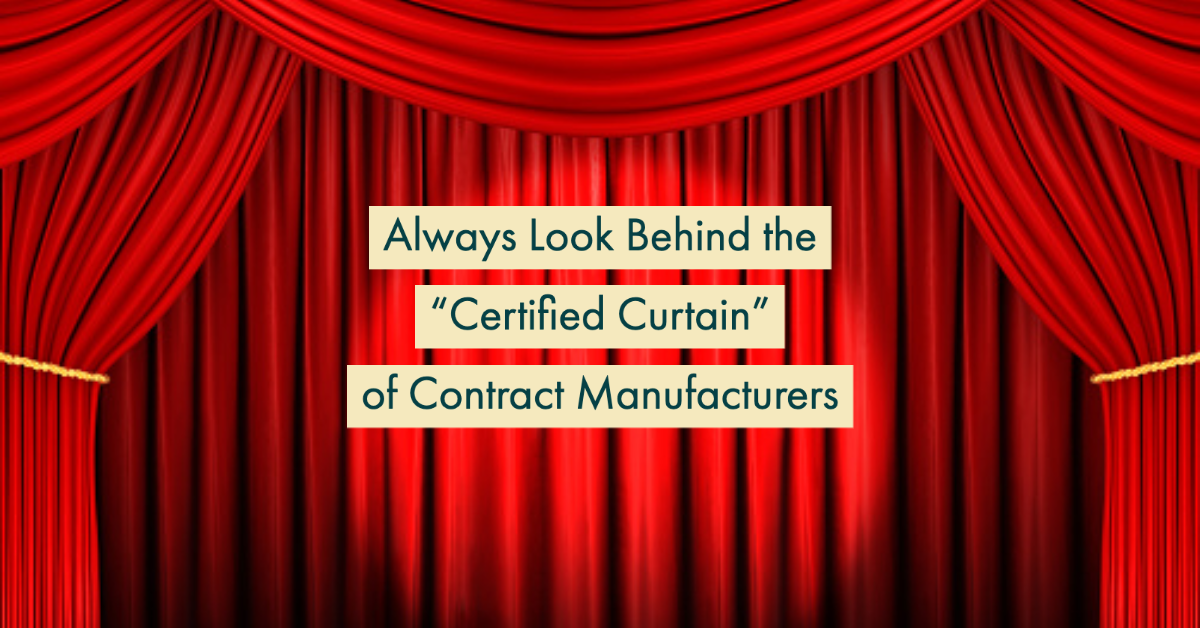Always Look Behind the "Certified Curtain" of Contract Manufacturers
Your company is now ready to begin the investigation of outsourcing your new product and there are many “certified” Contract Manufacturers (CM) to choose from.
Many of these Contract Manufacturers advertise a list of certifications. We recommend that you peel back the “Certification Curtain” in your investigations. Here are some things to look for as you are weighing your CM options:
Do they have a dedicated Quality Staff?
Please take the time to meet the Quality staff. This key role in some companies is, unfortunately, a “shared” responsibility”, meaning they have an employee that is, in fact, wearing a quality hat only when audited or externally required. Quality is too many times considered “window-dressing”. To truly adopt and continually execute a Quality Management System companywide takes a lot of time and energy. This time and energy deservedly require a dedicated Quality team.
How experienced is their Quality Staff?
In your meeting with the Quality Manager please ask about their Quality experience and background. This pivotal role in a CM is not for a junior staff member, as the responsibilities are large and hopefully Company-wide. How do they interact with Operations, Supply Chain Management, and the other internal factions within the company? How do they guide and oversee the adherence to their certifications? We would recommend taking a factory tour with them…do the assemblers and technicians on the manufacturing floor know them well? Can they show you some of the daily quality trackers/reports as they move from station to station? Does it look like they are “active” and aware of the projects on the manufacturing floor? The Quality team at a CM should be a “roll-up-the-sleeves”, highly visible group amongst the manufacturing staff. Fully engaged in projects as they come in the door… all the way to packaging and shipment.
Do they have a Quality Management System (QMS)?
One of the most important aspects of a QMS is using it as a corrective action system. If a company is practicing true continuous improvement, their corrective action log will have activity with root cause analysis that goes beyond operator error. True improvement comes from process change, instruction development, and custom tooling It is worthwhile to ask to go through their documented, company-wide Quality Management System with them. Hopefully, the processes and procedures are easily accessible, and the respective Quality Manager can walk you through the process in a very straight forward, familiar fashion. As they are doing this, it is beneficial to understand how the other groups within operations are continually supporting the system and what their level of ownership entails. Successful Quality Programs rely on communication routines across the organization…periodic cross-functional meetings, reviews, banners, data sharing etc. Is that visible during your investigations?
Is there a Quality Training Program in place?
The manufacturing of quality products is based on the continual training of the people building and inspecting the products. Does the Quality staff have a training program in place? Can you see the documents? Does it encompass the executive, middle management, and all levels within the organization? A top-notch Quality Team has a vested interest in their training processes to ensure your product line is matched to the proper skill level.
Who does the Quality Team report to within the CM?
Who does the Quality Manager and team report to in the organization? What level of the organization do they reside in? Are they empowered to affect change at the management levels within the company? This is often where internalizing the respective certification processes and procedures fall short. The Quality Manager is typically much more successful in evangelizing company-wide “change-initiatives” if they have the buy-in and active support of the management levels of the given CM. Their processes and procedures need to become embedded in the very fabric of the company. Then the certifications are real.
Do they have a dedicated Inspection Lab?
When investigating the CM, it is beneficial to understand where the Quality Team performs their adherence to ISO-9001, AS9100, and 13485 as an example. Do they have a Quality Inspection Lab at their facility? If so, then a walk-through to see what inspection/metrology equipment they have is worthwhile. In addition, do they have a dedicated Quality person who runs the lab and maintains hard copy and soft copy records? Do they routinely calibrate the equipment with dated labels to indicate the last check/audit? When the Quality team is truly engaged in projects then it is usually apparent with parts in various stages of being inspected, kitted, labeled, and stored for the manufacturing phase. This can be seen while taking the tour in and around the respective inspection lab.
In summary, selecting your long-term CM partner is extremely important to the success of your product launch. As you go through your selection process, you will note that many CM’s advertise their respective Certifications. Given the importance of your selecting the right CM please take the extra time and energy to look behind the “Certification Curtain”. It will be a worthwhile step in ensuring you have made the right selection and that you will be delivering a quality product to your clients for many years.

